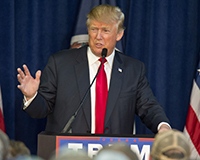
It doesn’t matter how big, populous or powerful it is – no American city operates in isolation. So before we delve into the inner workings and economic prowess of Los Angeles, a little context in the form of a country-wide overview is helpful.
The US economy is “back on track”, says John Williams, president of the San Francisco Federal Reserve, who points to “good” annual growth of around 2% as well as an unemployment rate of 5% – half what it was at the height of the last recession – to support his optimism.
Job creation is on the up, too, with the US adding about 200,000 new jobs a month for the past two years. At the same time, the country’s real estate industry is in fundamentally good shape.
Spencer Levy, CBRE’s Americas head of research, says: “The five major asset classes are all demonstrating very strong rental growth and occupancy improvement. The only area where we are concerned about a little bit of over-building is class-A apartments, but not on a national basis.
“There is actually a shortage of Bs and Cs,” he adds.
The Federal Reserve has not been shy of suggesting that its positive economic performance might prompt interest rate rises in the coming months – and property agrees.
“I would bet on two rate rises in 2016 – in September and in December,” says Levy.
Investment volumes of $111bn (£84bn) for the first quarter of 2016 were down by 19.8% on the equivalent period in 2015, according to CBRE’s US Capital Markets 2016 report.
But rather than signifying a sudden quelling of market activity, investment has reverted to a level similar to the first quarter of 2013 and 2014, while the Q1 2015 acquisitions volume was the second-highest total since the mid-2000s, which served to magnify the change.
CBRE’s Americas Investor Intentions Survey 2016 found that 39% of investors intended to make more acquisitions this year than they did in 2015, compared with 19% who said they expected their purchasing activity to decrease.
Commercial hotspots
Los Angeles, New York and Dallas/Fort Worth are the top three cities for investment in the US. “Los Angeles came out number one for a couple of reasons,” says Levy.
“One, it was a bit of a laggard behind San Francisco and New York in its recovery. And two, we expect LA to have the most new jobs formed in the next two years, and many of those are high-paying because of the concentration of the media industry.”
Residential hotspots
Residential opportunities tend to track the same path as commercial, but extend beyond the CBDs, with many seeing their suburban markets strengthen.
“Even though most of the trends you read say everything is about urbanisation, it’s not,” says Levy.
“Some people are considering the suburbs. In and around the major central business districts is where we are seeing most of the construction, even in some secondary markets, such as Cleveland, Cincinnati and Minneapolis.
“The multi-family construction story is probably the most widespread of all the different asset classes.”
Across the US, much of the residential supply expected in 2015 was delayed for a variety of reasons and, as a result, has been rolled over into this year. This, in turn, has led to anticipation in CBRE’s Americas Outlook 2016 report that this year will see the biggest single-year number of multi-family completions since the booms of the 1970s and 1980s.
 Growth areas
Growth areas
Multi-family pipped industrial to become the most popular property class, according to CBRE’s survey. Some 28% of respondents make it their first choice. Offices took second place with 24%, and industrial was third with 23%.
Risks and challenges
The US election is likely to cause some volatility between now and November, and the industry should factor in the risk of global shocks from emerging markets and powerhouses such as China, says Levy.
But the biggest area to be cautious of, he says, is concentrated markets in energy, tech or other industries showing signs of weakness. These include tech hotbed San Francisco and energy-dependent Houston, which have seen a rise in subletting activity.
The battle for the White House is in full swing
Against the odds, Donald Trump has swept his way to the Republican Party nomination. When the property tycoon announced his intention to enter the presidential race back in 2015, Paddy Power gave his chances of winning as 53/1. That has been slashed to 5/2.
For the Democrats, the most likely candidate is Hillary Clinton, a political veteran who has had two terms as First Lady followed by eight years as a US senator.
When American voters go to the ballot box in November, the world, and global property market, will watch with bated breath. With so much investment activity in US metropolitan areas, it is easy to see why.
According to a Q1 2016 ranking of markets by Real Capital Analytics, four of the top five were in the US, with sales volumes (international and domestic) totalling close to $72bn (£49bn).
US cities also dominated a ranking by overseas investment in the first quarter of 2016, taking six of the top 10 spots, with New York, Los Angeles and San Francisco placed first, third and fourth, respectively.
So will global investor appetite diminish if The Donald sits in the Oval Office?
Speaking at LREF last month, Linus Forsberg, partner at Trinova Real Estate, said a Trump presidency would lessen the appeal of the US to global capital. “Some parts of the Middle East and China currently consider the US and UK as their primary targets. If the US becomes less attractive, it would have to benefit London and the UK.”
But Dominic Grace, Savills’ head of London residential development, pointed to the unfeasibility of Ronald Reagan – a “has-been actor from California” – as president when he first announced his intention to run. “There was probably a bit of chuntering when Reagan was elected, but we look back and say ‘He did great work’,” said Grace. “On balance, I don’t think it will make a lot of difference, truthfully.”
• To send feedback, email janie.stamford@estatesgazette.com or tweet @JanieStamford or @estatesgazette
LA SPECIAL










